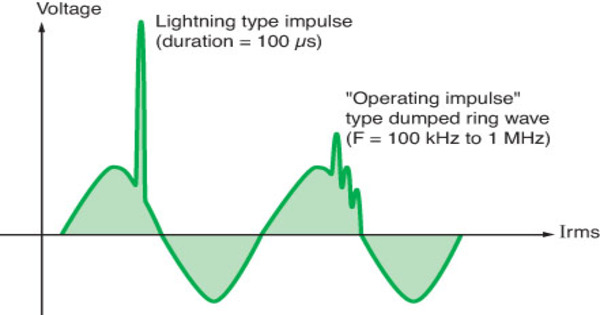Overvoltage in electrical engineering refers to a voltage increase that exceeds the design limit of a circuit or circuit element. It describes a condition in which the voltage in a circuit or system exceeds its typical working range. The conditions may be hazardous. Depending on its duration, the overvoltage event might be transient—a voltage spike—or persistent, resulting in a power surge. Lightning strikes, switching transients, power system problems, and equipment malfunctions are all possible causes of this.
Overvoltage can cause electrical equipment damage, insulation breakdown, and potentially pose a safety risk to personnel. To reduce the hazards of overvoltage, engineers use a variety of safety measures such as surge arresters, voltage regulators, and insulation coordination techniques.
Explanation
Electronic and electrical devices are designed to function at a specific maximum supply voltage, and voltage levels higher than that for which the devices are rated can cause significant damage. For example, an electric light bulb contains a wire that, at the rated voltage, will carry a current large enough to cause the wire to get very hot (emitting light and heat), but not hot enough to melt.
Surge protectors, for example, are frequently used to direct excessive voltage spikes away from sensitive electrical devices, assuring their safety. Furthermore, good design considerations and frequent maintenance help to reduce the frequency and impact of overvoltage incidents in electrical systems.
The quantity of current in a circuit is determined by the voltage supplied; if the voltage is too high, the wire may melt and the light bulb will burn out. Other electrical equipment may also cease operating or even burst into flames if an overvoltage is applied to the circuit.
Some common methods to protect against overvoltage include:
- Surge protectors: These devices are designed to divert excess voltage away from sensitive equipment by shunting it to ground. They are commonly used in residential, commercial, and industrial settings to protect electronic devices from transient voltage spikes.
- Voltage regulators: These devices maintain a stable output voltage by automatically adjusting the input voltage to compensate for fluctuations. They are often employed in power supply circuits to ensure consistent voltage levels despite variations in the input voltage.
- Lightning arrestors: These devices are installed in electrical systems to protect against lightning-induced overvoltages. They provide a low-impedance path to ground for lightning currents, preventing damage to equipment and structures.
- Overvoltage relays: These protective devices monitor the voltage level in a circuit and trip when the voltage exceeds a predetermined threshold. They are commonly used in power distribution systems to isolate faulty sections and prevent damage to connected equipment.
















